(Oh, what a beauty!)
I can tell we are tapering off summer by a number of things: my calendar gets filled with upcoming events that are actually important for me to remember, the invitations to come over for a “fun” day of scrolling through thousands of pictures of somebody’s recent vacation have dwindled (thank goodness), and the evening hour of bedtime for my children becomes no longer just a suggestion. But I really know we are approaching late summer when the berries on my American beautyberry bush start blushing their way from chartreuse into a brilliant, magenta-purple color. Come fall, the shrub will be positively dripping with these vibrant berries.
(See the progression of color from right to left? And the berries just get deeper in color as the fall progresses.)
The American purple beautyberry (Callicarpa americana) is a wonderful sight to behold. A common shrub found along creeks in the Hill Country, the beautyberry can also be a showpiece in city landscapes. With its low maintenance care, no need for fertilization, and virtual pest and disease free status, who wouldn’t want to try out this stunner. The beautyberry can be adapted to grow in either full sun or partial sun. It will produce more berries with more sun exposure, but you will also need to supplement more water. Basically you are looking at needing about an inch of water per week for your beautyberry to thrive. From a water necessity standpoint, the beautyberry does best when it gets a little reprieve from direct sunlight later in the day because you can get by with less watering and the leaves won’t have wilted or dropped by the the afternoon. Most existing soils are fine for the beautyberry, as it doesn’t have much of a preference, as long as the soil is well-draining. However, if you already know you have extremely poor soil, you should add some compost before you plant.
(This beautyberry was planted beneath another tree, but the tree died, and the beautyberry has adapted to being in full sun.)
Fall is a great time to plant the beautyberry. If you’ve got a nice wide space that you are looking to fill up, you should really consider this deciduous shrub. The beautyberry can grow about 3-8 feet high and 4-8 feet wide. When it’s branches are loaded with berries, they arch out and cascade over to form a wonderful umbrella shape. Even with this shrub being deciduous (losing it’s leaves in winter), the berries hang on to the stems to give you color interest in the wintertime. Don’t bother pruning the stems through the winter and leave the berries on the leafless stems for the birds to enjoy. If the birds don’t gorge themselves on all of the fruit, you can continue to have color with the berries for many weeks after the leaves drop. As for when to prune, if you’ve given your beautyberry plenty of space to grow, you won’t have to do any pruning until late winter or early spring. Blooms occur on new wood, so if you wait until late winter or early spring to cut back the beautyberry it can be treated like a perennial and be cut back nearly to the ground. If you haven’t given your plant enough space to stretch out it’s limbs, you may find yourself regularly pruning to control its size. Come springtime, fuzzy, light-green leaves will start sprouting again, and then from about June-August you will be presented with small, clusters of lavender-pink blossoms that give way to the beautiful berries.
(No leaves, no problem. The berries still look great and now the birds can find them better!)
The birds aren’t the only thing to nibble on the berries. Some people choose to collect the berries to make a jam that is similar in taste to that of the elderberry. Some have taken to munching a few berries raw right off of the stem. I think they have a slightly medicinal taste that I don’t care for myself. Although the berries are not poisonous, it is advised that when trying out the berries, go slow and try a couple at a time to see how they settle in your belly. American Indians would steep the berries and make a tea to treat illnesses. The leaves of the beautyberry contain insect repelling properties and have been used by many to keep biting bugs at bay. Crushed leaves scattered around your feet when sitting on the patio may keep your legs free from hungry mosquitoes. Plucking a few leaves and tucking them in your hat or pockets, or crushing the leaves and rubbing them on your clothing, could prevent an insect attack while working in the garden. Again, you would need to be cautious about rubbing the leaves directly onto your skin, as the oils could cause an adverse reaction in some people. There are many different recipes online to make your own insect repellent sprays or creams out of the beautyberry that you could try. I hesitate to link to any here only because I have not tried any myself. Once I do, I’ll be sure to share the best ones with you. Same thing goes for the jam recipes, but as fall comes around and my berries get that rich purple color, you can bet I’ll be giving some recipes a try.
(Try making some jam from an internet recipe. If you find a great one, let us know!)
Although I’ve been talking exclusively about the American purple beautyberry (because it’s my favorite), there are other varieties of the beautyberry to consider. The Chinese beautyberry (Callicarpa dichotoma) is similar to the American variety but with a slightly smaller form. The berries are daintier and the leaves are more slender than the American version, but you get the same ease of care and beautiful purple berries with both varieties. Other varieties include: Summer Snow beautyberry (Callicarpa dichotoma ‘Summer Snow’) which boasts variegated foliage with a creamy-white margin, the White American beautyberry (Callicarpa american alba) which boasts gray bark and snow-white berries, and the Mexican beautyberry (Callicarpa acuminata), also called the “black beautyberry”, that presents its berries with a deep, dark, wine hue. Whichever variety calls to you, whichever you choose to plant, you’ll know that you are literally bringing “beauty” into your landscape.
(The deep-wine colored berries of the Mexican beautyberry.)
(This beholder definitely sees the beauty!)
-The Happy Gardener
-Lisa Mulroy

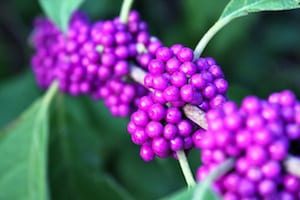

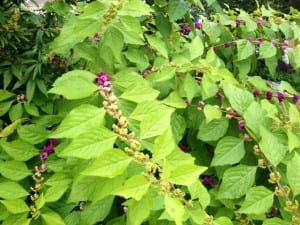
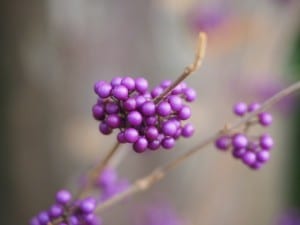
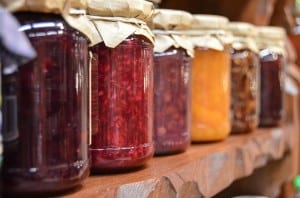
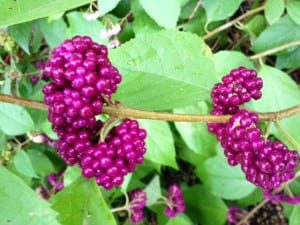

Are all of the types you mentioned in the article above native to North Carolina?
Hi Pam,
I would recommend searching some of the NC native plant databases for native plants in your area. We are based out of San Antonio, Texas, and that is our area of expertise. However, it looks like the American Beautyberry is also native to NC according to this site. and also this site.